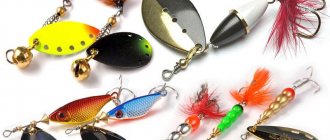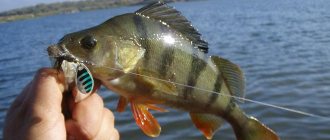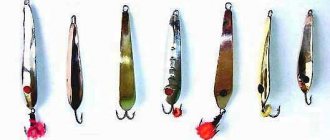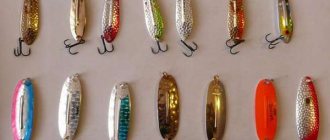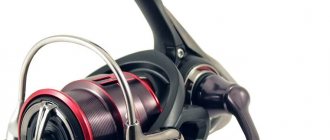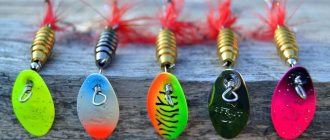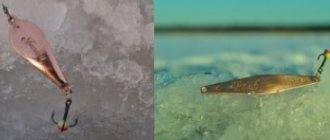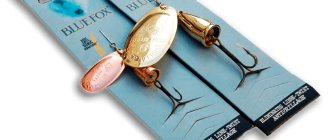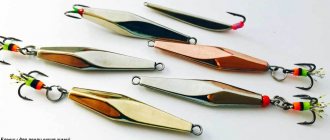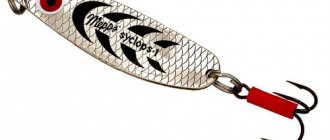Weighting the core of the spinner - long-distance casting of the spinner
I love fishing with a spinner.
But it’s rare to catch it, because... on Pina you can’t always get to a catchy spot. I decided to somehow deal with this problem. I hooked a Cheburashka weight on the front of the spinner. Yes, the spoon began to fly much further, but on every third cast I was plagued by constant overlaps. This will not work! We must look for some other way out. First, let’s figure out why the spinner with the “Cheburashka” gets caught in the fishing line. The fact is that the load has almost the same (or even more) weight than the spoon itself. Therefore, during the flight, he rushes forward, leaving behind the spoon, which clings to the fishing line. This process is schematically depicted in Fig. 1. Accordingly, the closer to the end of the bait the load is located, the less likely it is to get caught.
Rice. 1.
But how to weight the bait if the core is located in this place? There are two options: make the core heavier or make a new one.
Spinner equipment and its elements
There is a small group of spinners that do not have any weight of their own (Fig. 1).
Fig. 1. The simplest unloaded spoon.
The weight of such spinners is minimal, and it is difficult to throw them a sufficient distance, so they require the presence of a separate (remote) sinker. The shape of such a sinker should be eccentric to prevent the line from twisting.
A spinner with a separate weight resembles a spinner with a weight-head, in which this element is installed separately. Therefore, any petal is suitable for an “independent” spinner, because the removed sinker does not in any way prevent it from rotating.
Body
Most “individual” spinners are small in size and, accordingly, have less noticeable light and sound play. Therefore, such models are especially often made with a resemblance to a natural body and tail (Fig. 2).
Fig.2. Spoons with body and tail: a) twister, b) cambric and thread, c) bead and fly.
Many small “fly spoons” do not copy fry, but rather various insects and their larvae.
Equipment with hooks
Instead of a regular tee, spoons can also have special hook rigs (Fig. 3).
Fig.3. Special equipment: a) with a streamer, b) with a hook on a leash.
For example, the Aglia Streamepps spinner is equipped with a small streamer, and the Special mulet is equipped with a single hook on a 5-centimeter leash made of fishing line. The latter option involves placing a worm or other bait on the hook. This combination is intended for cautious chubs, who often follow the spoon all the way to the shore, but for some reason do not take it. In this case, the worm dangling in front of the nose still forces the fish to grab the natural “supplement”.
I way to make the core heavier
To make the core heavier, you can simply wrap it in a soft strip of lead (such strips or plates are sold in any fishing store). This procedure is done very quickly, often even on a pond. This method is very mobile and requires almost no costs. The main thing is not to overdo it with lead, otherwise you will get not a pinwheel, but a grenade, on which even the petal rotates with difficulty.
I use this method when I go to an unfamiliar body of water. Depending on the fishing location, I wrap a certain amount of lead on the core. If necessary, you can finish it more or remove it altogether.
The disadvantage of this method is that the design is short-lived, and during long-term fishing the lead must be constantly adjusted. That's why I rarely use the first method.
Tactics for fishing with unloaded spinners
The tactics of fishing with a separate spoon differ little from the tactics of fishing with a “big-headed” spinner. Therefore, in cases where the fish is clearly alarmed by the combined sinker, we use a separate arrangement.

It’s just that some fish don’t like “rough” spoons. For example, when fishing for ide, chub and medium-sized asp, I use only a separate sinker. And even a seemingly simple-minded perch is often capricious - you have to change gears here too.
I remember how my son and I caught a “striped fish”. He, then still a schoolboy, was given a spinner with a head that was more convenient for casting, and he was given the same model, but with a separate front sinker. However, after the score was 5:1, the son demanded to change baits. The argument that he does not know how to slow down the tackle and it will get overwhelmed did not convince his son. I agreed and decided to test the effectiveness of these two options. As a result, at the end of the fishing the score was approximately equal, despite its age and frequent overlaps. To this day, my son jokes that his dad almost sold him the “left” spinner.
II method
The second method is more labor-intensive. There are also a lot of options here, but we will consider only two.
Option 1. I make a copper core by winding it onto a tube rod. You can use round copper wire with a diameter of 1 to 2 mm or flat wire from the winding of a car starter. I use a copper tube with an outer diameter of 3mm from the refrigerator relay. If there is no tube, I use a liner twisted from copper wire with a diameter of 1 mm on a nail 1.5 mm thick. Before starting work, the wire must be carefully aligned and cleaned. I wind the wire around a nail with a diameter of 3 mm to protect the rod-tube from deformation. I clamp the nail in a vice and wind the wire tightly, turn to turn. When winding flat wire I use pliers. I grind the resulting spiral on an emery wheel until the protruding ribs are compared, then I saw it into pieces of the required length and align the ends. I place each workpiece on a thinner nail so that it rotates freely, and grind it again using sandpaper, giving it a cylindrical shape. Then I sharpen the head part of the core. Next, I sand the core with fine sandpaper and polish it on a felt wheel. To prevent the cores from dulling, I coat them with varnish, having previously degreased them.
Option 2. The second option is a little easier than the first. But you need to have some skills in working with a casting mold. Disassemble the spoon and remove all parts from it. The old frame can be thrown away. Prepare a new elastic wire that fits all parts. It is important that the clamp rotates freely on it. Then cut out a mold from a potato tuber. Pour in the lead and, while it is still warm, press the bushing into it, which helps the clamp slide. When the lead has cooled, carefully remove the workpiece from the tuber and smooth out all the irregularities with fine sandpaper. Now you can equip the spoon to the end.
Rice. 2.
Put on a reflector, a ball, a petal with a clamp and, using pliers, bend the ring for the fishing line. You can also wear a winding ring with a swivel. To attach the hook, place the hook on the rest of the wire, bend the ring and secure the wire tightly, biting off the excess end. The converted spoon is shown in Fig. 2.
To increase the casting distance, it is necessary to make the spoon heavier. Instructions - a guide to weighting spinner spoons for amateur fishermen is successful, completed.
How to weight different types of spinners
3 minutes Author: Konstantin Pavlov 0
Often when fishing there are conditions in which the weight of a spinning bait plays a key role. Often the own weight of an artificial fish is insufficient. This situation occurs when you need to cast to a remote catching point, or when making a retrieve in a fast current, or if it is important to quickly deliver the spinner to the lower horizons of the reservoir. Knowing how to weight a lure will help in any of these cases and will make fishing more interesting and its results positive.
Which lures should be weighted?
When talking about weighting, it should immediately be noted that such manipulations should only be performed with rotating spoons. The fact is that adding weighting changes to the spoon will greatly change its game, which can negatively affect the performance of the spoon. The result of the modification in this case will also affect the spinner’s overall catch.
Weighting the turntable will not affect its performance, since it does not affect the main working element - the petal. Here you only need to increase the weight of the core.
Wiring options for unloaded turntables
When fishing with “separate” spoons, in the vast majority of cases, uniform wiring is used, and only occasionally – striking or stepped. Moreover, it is desirable that only the sinker contacts the bottom, and the spoon itself goes a little higher and does not catch the dirt.
A rig with a front sinker can provide just such advantages, because at the moment the sinker falls to the bottom, the light spoon “slows down” for another second or two, and with a new pull it passes over the very bottom without catching it. Thus, the spoon remains in “combat readiness” all the time, because a predator rarely takes the bait “from the ground.”
By the way, “slowness” is always inherent in rigs with a front sinker, because due to the long leash, the spinner, unlike the sinker, does not change the direction of movement so abruptly, and its play is more stable.
Equipment with a rocker arm is, in principle, designed for striking wiring; the main thing is to accurately select the weight of the sinker so that it strikes along the bottom, and does not “plow” it.
An interesting feature is the “rocker arm” with free attachment of the spinner. In this case, the petal more easily adapts to movement in different directions and can continue to rotate not only when inclined, but even when falling vertically. This means that such equipment is very attractive for step retrieving, because only the sinker can be lowered to the bottom, and the spoon itself will go higher without hooks. True, here you need to put a lightweight sinker so that when pulled, the bait comes off the bottom to the required height.
Other weighting methods
In addition to making changes to the design of the bait, there are other ways to increase the weight of the equipment. For long casting, stability of the bait and its quick delivery to the desired horizon, the following is used:
1. Equipping with a bombard - a special float with positive, neutral or negative buoyancy.
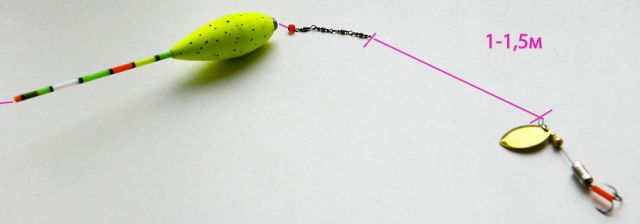
2. One of the spaced jig rigs:
- splitshot,
- diverter leash,
- Texas,
- Carolina
Which option to choose depends on the fishing conditions and the angler’s preferences. “American” rigs work better in grass, and Moscow rigs in snags.
If you simply put additional weight in front of the spoon, like using a jig “Cheburashka” with an offset hook, the position of the center of gravity of the equipment will change, which is fraught not only with a malfunction of the bait, but also with the leash tangling behind the rear tee when casting.
Features of the game of unloaded turntables
The rotation of the petal twists the line between the spoon and the sinker, which leads to loops and frequent overlaps. To avoid this, we place either a thicker line or a braided line on the problem area - twisting affects them less. True, in the case of a “dead” hook, you will have to tear off not only the spoon, but also the sinker.
Another drawback is that the tackle often requires a leash. If we catch an asp or chub, we don’t need a leash, but for every ten perches there is usually at least one pike. And the “toothy” one doesn’t care even about strong wicker. There is only one way out - to place a metal leash between the spoon and the sinker. At first I made it simply from musical string, now from soft leash materials.
But all these small disadvantages cannot overshadow the advantages of a “separate” spoon, such as minimal size, easy play and the ability to catch the most cautious fish.
Weighting order
In order to make a spinner heavier, you need to replace the standard core with a weight made of heavy metal: lead or tungsten. Ready-made fishing elements with ready-made holes will help us with this, such as:
- sliding weights;
- winter jigs.
In the first case, we will simply replace the standard core with a sliding weight. In the second, we remove the hook from the jig and put the ball on the axis of the bait.
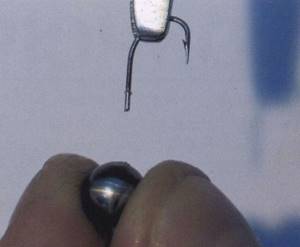
There are several other ways to increase the weight of the spinner. In the first case, a lead plate or wire can be used as a weighting agent, which is glued to the core. The load of the bait will also increase if you clamp an ordinary lead pellet of the required size on the tee of the turntable.
If during fishing you experience inconvenience when working with light bait, and you don’t have a heavier spoon with you, you should try to increase the weight of the existing one. To do this, you can use standard sinkers or jigs, and work with ordinary pliers.
Zhukovsky K. Weighting the spinner
Any spinner knows how important the weight of the bait is for making long casts, for guiding the spinner in strong jets of fast currents or at the very bottom at great depths. In my article I will tell you how you can approximately double the weight of a spinner using a tungsten core. Manufacturers use the following materials for the manufacture of rotating spinners with axial loading: copper, brass, lead.
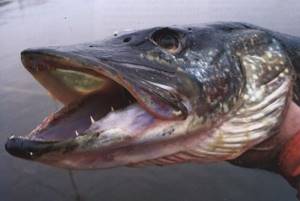
A little theory
Copper, brass and lead are significantly lighter compared to tungsten, since it has a much higher density, and therefore more mass, compared to other materials.
Material
Density
If we take four balls of the same weight, but from different materials and measure the diameter of their circumference, we will get the following picture. The diameter of a tungsten ball will be the smallest compared to the diameters of other balls.
Modernization and equipment of spinners
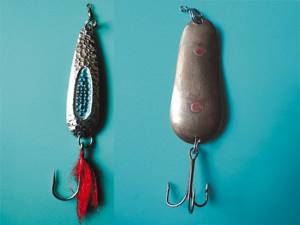
Proven oscillating spoons Photo by the author
When fishing with a spinning rod, a lot depends on the correct choice of bait in each specific case. The ability to navigate among a huge variety of spinning baits is the main key to success in fishing. But there are spinning anglers who prefer to thoroughly master one type of bait. This time we will talk about hardware.
Usually, domestic reference publications on fishing in the section “Spinning baits” begin to educate the reader, as a rule, by talking about oscillating spoons. In a sense, this is justified, since Russian spinning began with fishing with an oscillating spoon. And today this bait has not lost its relevance.
No matter what the hotheads predict, it’s too early to send the oscillating spoon to the closet as a type of bait. This is completely obvious. Moreover, we can speak with complete confidence about the positive results of factory modernization of lures of this type, which is expressed in improving geometry, increasing or decreasing weight, using various inserts such as eyes or beads, and special coatings, for example, using flash technology. A special place is occupied by special bimetallic spinners with electrical potential. Among the spinners produced by our industry, the most popular are “Atom”, “Playing”, “Neman”, “Toby”, “Wonderful” and some others.
A good oscillating spoon during the retrieve quite accurately imitates the movements of a live fish. The wiring can be either uniform (in a given horizon) or stepped. It is important to choose the bait that is most suitable for certain fishing conditions. Let's consider this requirement based on the specifics of using a specific spinner.
Blue Fox, for example, makes a spinnerbait called the Trixee (pictured). The unusualness of this bait is that with a length of 75 mm and a width of 20 mm, it weighs only 7 g. The lightweight design nevertheless allows it to be used in various conditions, since the spoon is equipped with a single hook designed for fishing in combination with a whole dead fish or with its piece, large crawl, twister, vibrating tail, octopus. A spoon equipped with a hook is practically not susceptible to snagging. It can be fished both in overgrown shallow waters and in deeper places. Trixee is available in two colors: silver and gold, with brightly glowing red or blue plastic inserts. Such an application, according to experts, has a particularly irresistible effect on Atlantic salmon and trout.
Tests of these spinners, carried out by me on reservoirs near Moscow and in the Volga delta, showed that this is, first of all, an excellent bait for pike. During the wiring, she is somewhat reminiscent of our “Playing”. However, the toothy predator notices it from a longer distance, which indicates that the nature of the microwaves propagated by Trixee is more attractive.
How to cast a spinning rod correctly?
Before throwing, be sure to follow the following rules:
- It is imperative to carefully look around to see if there are people, trees, or bushes behind you, but the most important thing to do is to look up to see if there are any wires that can cause serious harm to health. It is also desirable that there are no overhanging branches over your head, to which hooks and fishing line will cling when casting.
- Release the line at an angle of 45 degrees if you want to make the longest cast.
- Casting accuracy can only be learned over time by making a large number of casts while fishing, swinging the rod with a certain effort and releasing the line at the most appropriate time, and then not forgetting to point it in the right direction. Here the best teacher will be time and constant training.
When fishing with a spring, you should know that the weight of the tackle is of great importance.
But fishermen recommend adhering to the following tips:
- First, place the spinning rod on your shoulder.
- Then we rock the ball with bait a little.
- At the moment when the spring, swinging, takes the farthest direction from the back, quickly cast, not forgetting to gradually increase the flight speed and release the line at an angle of 45 degrees.
This will unload the rod and line, which will prevent the spinning rod from breaking.
How to properly weight a spinner?
The fishing market has a wide selection of spinners for catching different types of fish. For example, the following baits are more adapted for predatory fish:
- Oscillating and rotating spoon
- Castmaster
- Fly spinner
- Devonian
- Spinnerbait
The need for loading usually appears when the weight of wobblers purchased in a store is insufficient. On the water, some behave like floats and, at the most critical moments, even jump to the surface. Let's consider several methods involving the use of lead materials. They are easy to use because they are not very hard.
- Suspendots
. Suspendots – These are lead stickers. This option is suitable for light-weight wobblers such as crank or minoche. This method is not cheap. The price of suspensions depends on their weight. The heavier it is, the more expensive it is, therefore. They are very simple to use: stick to the previously degreased surface of the wobbler, usually this is done in the belly area. Although this is considered the most successful option, it still has its drawbacks. When fishing for a long time, the suspension needs to be adjusted. Also, such stickers are not suitable for long-term storage. They dry out quickly and when you try to use them, the adhesive substance remains on the canvas, so they must be used immediately after purchase.
- Lead plates
. This option is suitable for larger wobblers. The essence of loading is that a lead plate is glued to the belly of the spinner on a previously degreased and cleaned surface. To select the correct weight of the plate, you can glue it with chewing gum and experiment in a pan in the bathroom or in any container with water. If the load is too heavy, then it is quite easy to unfasten it and trim it to the desired weight. And so check until the required weight is selected. You can take a lead plate from an old cable or, in extreme cases, ask someone.
- Temporary loading
. This loading is done using wire. This is the easiest option. To do this, we wind the wire around the lure and also check the weight in a container of water, cutting off excess pieces if it makes the wobbler too heavy. If, on the contrary, the loading is too light, then we take the wire a little longer and attach it to the bait.
- Weighting the turntable
. We weigh the spinner with a strip of lead. To do this, we wrap the core with this material and secure it. The disadvantage of this type of loading is that it needs to be monitored during long-term fishing and often adjusted. This method is not durable, but it has its place. You can also use a rod that weighs a little more. Fish almost always react positively to such bait.
Loading spinners is like jewelry work. It is necessary that the fastening of the material is of high quality. Otherwise, when you arrive at the fishing spot with the first cast, you will lose the load and it will take you more time to re-make the load. This will greatly distract you from what you love. Thus, fishing will not be fun.
How to properly weight a spinner for long casting
Small spoons do not give the result that can be achieved with weighty parts, so many fishermen want to know how to weight a spinner spoon.
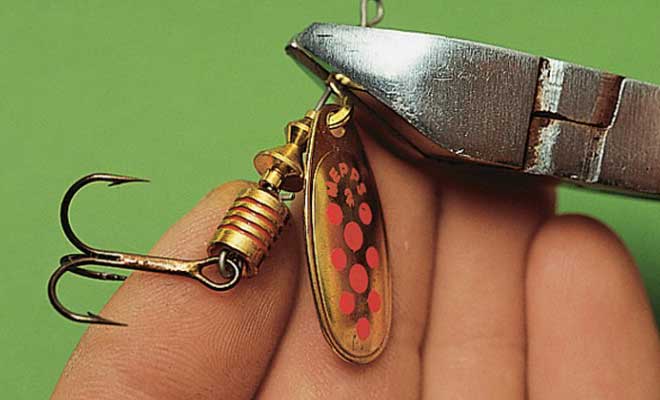
This manipulation is performed only with rotating elements.
Do this when necessary:
- Throw the bait as far as possible, but the light elements will not reach.
- When there is a strong wind outside or a strong current, the spinner is constantly blown away.
- If there is a need to deliver the element to the bottom as soon as possible.
Therefore, if you want to increase the weight of the spinner, it is best to use a core made of tungsten.
I would like to immediately say that many companies make artificial baits mainly from lead, brass and copper. Such elements have proven themselves to be the best. However, they are bought based on special fishing conditions. When they change, it turns out that the part does not meet all the requirements. There is no particular point in buying something else if the angler decides to experiment just once and fish in a way he has never done before.
In this case, the ideal solution would be to use tungsten. The fact is that the density of the latter metal is 18.8; while the density of brass is only 8.7; lead – 11.4; copper – 8.9. From this we can conclude that products made from tungsten are much heavier than all others. Moreover, the diameter of the ball can be completely insignificant. Therefore, this material will be used as a weighting agent.
Methods for weighting a spinner
Before you begin to weight the spinner, you should prepare all the tools and materials that may be needed. It is best to purchase small tungsten jigs, which in this case are perfect.
Important! When buying tungsten jigs, you should pay attention to the hole inside them, which should be at least 1 mm.
As for the diameter of the bait itself, it can be from 4 to 7 mm. In addition, you will also need to take a rigid wire with a cross-section of 0.5-0.8 mm. If we talk about tools, then you will need to stock up on wire cutters and pliers.
Having purchased everything you need, you can start.
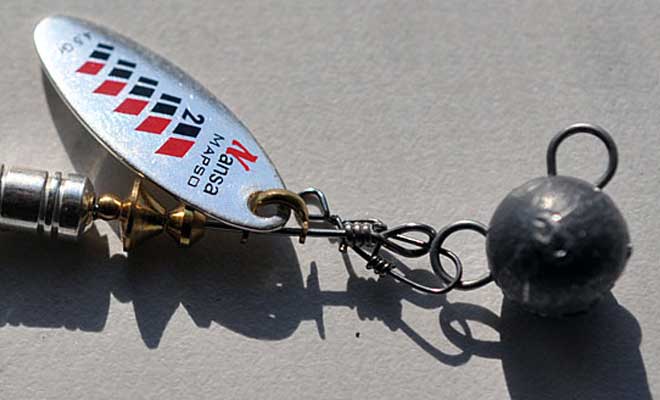
I would like to say right away that many fishermen weigh down elements that have proven themselves to be the best. Many of their spinners are universal, and the rotation angle is 45 degrees. This means that such an element can be used everywhere. If you make it even heavier, then there will be no value for it.
Basic rules for spinning casting
Place for casting
An important criterion for the success of any fishing, and especially spinning fishing, is its location.
Ideally, it should meet the following requirements:
- Security;
- Convenience;
- Catchability.
The safety of casting with a spinning rod should exclude the possibility of accidental snagging of yourself, other people and animals. Also, sometimes accidents happen with wet fishing line snagging electrical lines, which you need to be especially careful with.
In addition, you need to pay attention to shoes, weather, soil and its inclination. In wet weather, on clayey, sloping banks with vigorous casting, it is very easy to slip and get injured.
Particular attention is paid to the safety of casting from the water surface: you can fall from the boat or puncture the inflatable side, and when casting in fishing suits from a wade (when using a military OZK), there is a danger of turning over when entering water more than hip-deep - this is extremely dangerous.
In some cases, the comfort of the area can be neglected, but if there is a choice of a more convenient coastline with the absence of lush and overhanging coastal vegetation, then it is better to cast there.
The catchability of a spinning fishing spot often depends on good knowledge of it, which is achieved through observations, questioning and experience. It is very desirable to be able to recognize the range of a roll, the approximate depth, and learn the locations of washouts, holes and snags. An echo sounder and depth gauge are very helpful in studying the water area. Spinning fishing can be carried out both in large expanses of water and in very small bodies of water.
Usually the fish likes to stay a few meters from the beginning of the roll, where you need to take into account the strength of the current and balance it by reeling. In the warm season, good results are obtained by casting from boats from the shore to the middle of the water, as well as vigorously moving baits over thickets of algae.
If it is possible to fish with a spinning rod near dam structures, especially in large bodies of water , then there is a high probability of getting very significant trophies. At dams you can fish on both sides of the spillways. Perch and pike stay in quiet places, avoiding areas of falling water, and pike perch likes to walk in places where the water pressure weakens. Catfish, ide and goloval are caught with bottom wires, and asp with top wires.
In ordinary bodies of water, steep banks, areas of drift and depth changes with holes and banks are considered particularly catchy places. Various underwater ridges are fished with perpendicular movements, rather than longitudinal ones. In general, more successful fishing is always achieved by transverse fishing, rather than parallel to the current.
Certain reliable fishing spots need to be noted (best by photographing them on your phone and marking them on an electronic map). Sometimes, in deserted places, fishermen place guide buoys for designated casting points. Spinning fishing, as an active sport, involves trial fishing of all potentially fishing places, regardless of their type: appearance can be deceiving.
For example, abandoned industrial pits or small ponds and rivers can unexpectedly yield significant fish on test runs, especially for pike and perch. But in shallow places, and especially on various shallows, it’s unlikely that you’ll be able to catch anything other than a small, rare pike perch. As the spinner gains experience, he learns to intuitively discern potentially fishy terrain.
Balance of tackle when casting
The comfort of using spinning tackle largely depends on its balancing. In this case, balancing means the center of gravity of the entire rod as a whole.
Optimal rod-to-reel ratios fall into three categories:
- Weight. By moving the spinning rod along the edge of your palm, you find its center of gravity: the closer this point is to the grip of the handle, the better - with a well-balanced spinning rod you can fish for a long time without arm fatigue.
- Power. Depending on the weight and length of the spinning rod, the size (powerful or light) of the reel is selected. For example, a reel size with markings of 2500 units. considered the most universal, suitable for spinning blanks with dough from 25 to 30 g.
- Sensitivity. Determined by the optimal casting accuracy and distance. The most casting spinning rods with a balanced handle and good acceleration are capable of throwing out the equipment completely without the use of centrifugal force, achieving a long casting distance with minimal effort. And the absence of excessive oscillatory impulses will ensure high throwing accuracy. The lighter the entire spinning structure, the higher its sensitivity, which is why light and balanced tackle is so highly valued.
